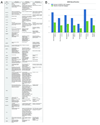Genetic advances in autism: heterogeneity and convergence on shared pathways
- PMID: 19477629
- PMCID: PMC2715429
- DOI: 10.1016/j.gde.2009.04.004
Genetic advances in autism: heterogeneity and convergence on shared pathways
Abstract
The autism spectrum disorders (ASD) are a heterogeneous set of developmental disorders characterized at their core by deficits in social interaction and communication. Current psychiatric nosology groups this broad set of disorders with strong genetic liability and multiple etiologies into the same diagnostic category. This heterogeneity has challenged genetic analyses. But shared patient resources, genomic technologies, more refined phenotypes, and novel computational approaches have begun to yield dividends in defining the genetic mechanisms at work. Over the last five years, a large number of autism susceptibility loci have emerged, redefining our notion of autism's etiologies, and reframing how we think about ASD.
Figures



References
-
- Association AP. Diagnostic and Statistical Manual of Mental Disorders edn Fourth. Washington DC: American Psychiatric Association; 1994.
-
-
Ronald A, Happe F, Bolton P, Butcher LM, Price TS, Wheelwright S, Baron-Cohen S, Plomin R. Genetic heterogeneity between the three components of the autism spectrum: a twin study. J Am Acad Child Adolesc Psychiatry. 2006;45:691–699.Demonstrates independent inheritance, with up to 90% heritability, of the three core deficits of ASD in both typically and atypically developing twins.
-
-
- Lauritsen MB, Pedersen CB, Mortensen PB. The incidence and prevalence of pervasive developmental disorders: a Danish population-based study. Psychol Med. 2004;34:1339–1346. - PubMed
-
- Prevalence of autism spectrum disorders--autism and developmental disabilities monitoring network, 14 sites, United States, 2002. MMWR Surveill Summ. 2007;56:12–28. - PubMed
-
- International Molecular Genetic Study of Autism Consortium. A full genome screen for autism with evidence for linkage to a region on chromosome 7q. Hum Mol Genet. 1998;7:571–578. - PubMed
Publication types
MeSH terms
Grants and funding
LinkOut - more resources
Full Text Sources
Other Literature Sources

